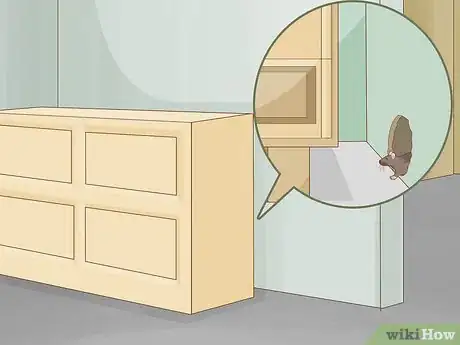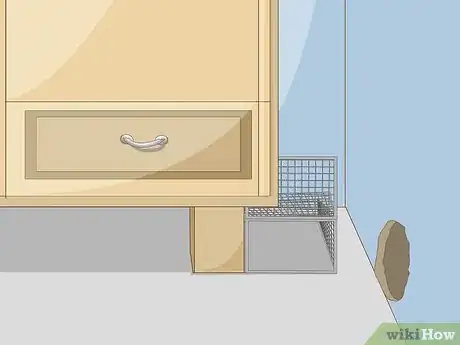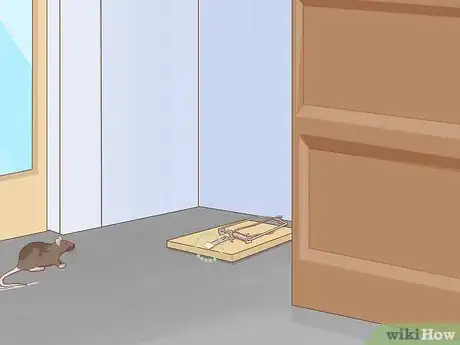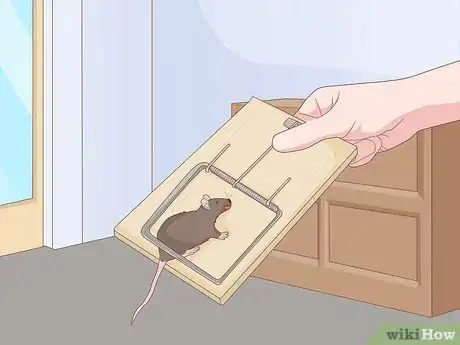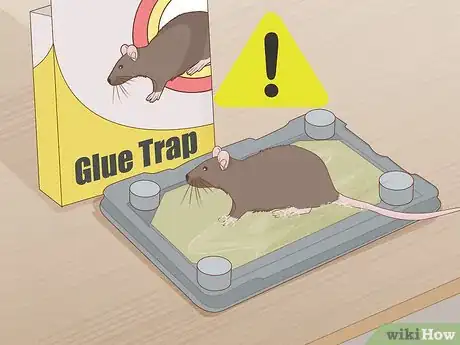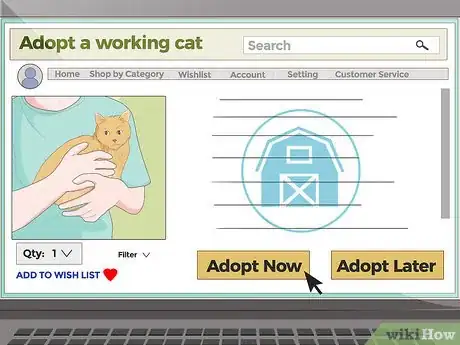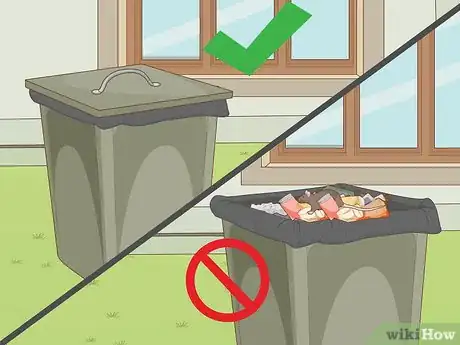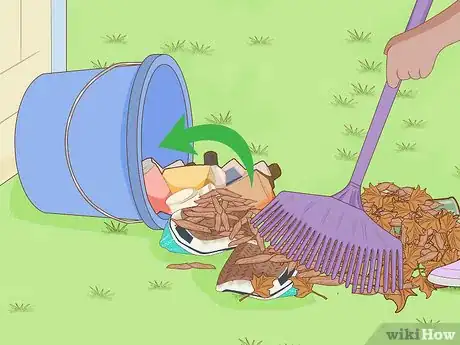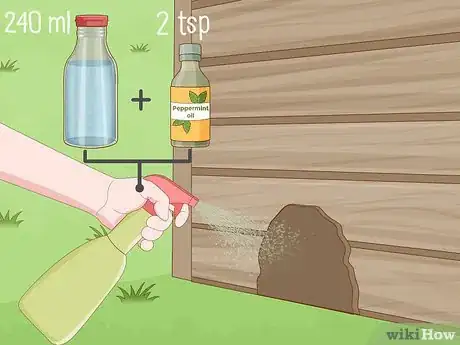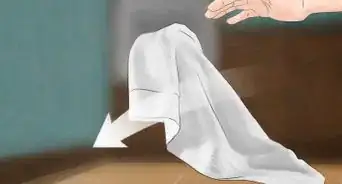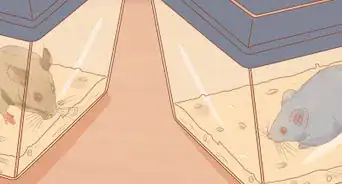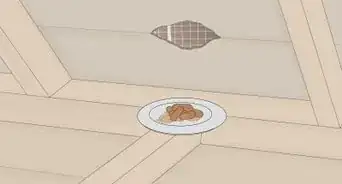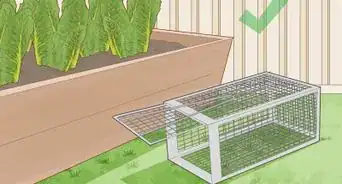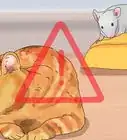This article was co-authored by Kevin Carrillo and by wikiHow staff writer, Megaera Lorenz, PhD. Kevin Carrillo is a Pest Control Specialist and the Senior Project Manager for MMPC, a pest control service and certified Minority-owned Business Enterprise (MBE) based in the New York City area. MMPC is certified by the industry’s leading codes and practices, including the National Pest Management Association (NPMA), QualityPro, GreenPro, and The New York Pest Management Association (NYPMA). MMPC's work has been featured in CNN, NPR, and ABC News.
There are 13 references cited in this article, which can be found at the bottom of the page.
wikiHow marks an article as reader-approved once it receives enough positive feedback. This article received 22 testimonials and 91% of readers who voted found it helpful, earning it our reader-approved status.
This article has been viewed 2,243,695 times.
Mice can be kind of cute, but it’s not so sweet when you see one scurrying through your house. Worse is finding traces of a mouse in your cabinets or closets, such as telltale droppings or even a nest. If you have a mouse in your house, you have several choices at your disposal. You can set a humane trap and release it outside, use a standard snap trap, or even get a cat to do the job. Seal your house, clean up potential food sources, and try using mouse repellents to keep mice out in the future.
Steps
How to Trap and Release Mice
-
1Track down the mouse. If you saw a mouse running by out of the corner of your eye, see if you can figure out where it went. Mice are pretty fast, and chasing them around the house usually isn’t the best way to catch them and remove them. Instead, track the mouse to its nest so you can catch it using a trap.
- If you didn’t see where the mouse went, look for the nest. A mouse’s nest is usually composed of scraps of cloth, paper, hair, and other odds and ends. It will have a musty smell. Look in the back corners of closets, under the sink, behind the refrigerator, in cracks in the wall, and in any other dark, hidden places.[2]
- You may also be able to track down the mouse by looking for droppings. Mouse droppings look like pieces of black rice. If you see some droppings, the nest is probably nearby.
- You can also simply set up the trap in areas where you know mice tend to gather in your home, such as your garage, basement, or kitchen.
Tip: Mice are quick and shy, so even if you have an infestation, you might never see an actual mouse. Instead, keep an eye out for hints such as droppings, chewed up food packaging, and musty smells around the house.[1]
-
2Set a humane mouse trap. Humane mouse traps let you trap a mouse without killing it. Most humane traps work by using bait to lure the mouse into a maze-like tunnel. When the mouse is inside, the trap closes behind it, making it impossible for the mouse to escape. You can purchase one of these traps online or in a hardware or home supply store.[3]
- Humane mouse traps tend to be a little more expensive than snap traps, but like snap traps they’re reusable, so it’s worth the investment.
- Bait the trap according to the instructions using peanut butter, oatmeal, or nuts.
- Set the trap near the mouse’s nest and wait for the mouse to come take the bait.
- Check the trap every day to see if a mouse is inside.
EXPERT TIPKevin Carrillo is a Pest Control Specialist and the Senior Project Manager for MMPC, a pest control service and certified Minority-owned Business Enterprise (MBE) based in the New York City area. MMPC is certified by the industry’s leading codes and practices, including the National Pest Management Association (NPMA), QualityPro, GreenPro, and The New York Pest Management Association (NYPMA). MMPC's work has been featured in CNN, NPR, and ABC News.MMPC, Pest Control Specialist
 Kevin Carrillo
Kevin Carrillo
MMPC, Pest Control SpecialistRestrict access to food sources to get rid of mice humanely. If the mice have gotten into your walls or ceiling, your best option to remove them is to make sure they have no access to food inside the house. Seal all holes and cracks that they can squeeze through. Eventually, they'll leave your house to go somewhere they can get food.
Advertisement -
3Build a homemade trap if you’d rather not buy one. You can also make your own humane live trap using materials you can find around the house or buy in a hardware store. This may be a cheaper option than buying a prefabricated trap. To make a simple soup can trap:[4]
- Take the lid off a soup can, empty the can, and drill a small hole in the base. Alternatively, you can take an empty soda can and poke a hole in the bottom with a screwdriver or awl.
- Take a bucket (ideally at least 5 gallons (19 L) in volume) and grease the inside with cooking oil to make the walls slippery. Drill 2 small holes on opposite sides of the bucket, directly under the rim.
- Feed a length of wire through the can and through the holes on the bucket, and make sure the can can spin freely on the wire. Wrap the wire through the holes on the bucket a few times to secure it.
- Lean a piece of wood against the bucket so the mouse can easily climb up and reach the wire.
- Coat the can with peanut butter. The mouse should crawl along the wire to reach the peanut butter, then fall off into the bucket, where it won’t be able to climb out.
-
4Release the mouse outside once you’ve trapped it. Don’t just take the mouse into your backyard to release it. Walk, bike, or drive your trap at least 1 mile (1.6 km) from your house, since you don’t want it to come right back inside. Release the mouse in a park or a patch of woods. When you’re ready to release the mouse, just open the trap and let it hop out.
- Some animal rights organizations advocate releasing the mouse into another building, such as a garage or shed on your property. This will give the mouse a greater chance of surviving, especially if it’s been living in your house its whole life.[5]
-
5Try shooing it out of your house. There’s one final humane way you can try to get a mouse out of your house: just shoo it outside! Sometimes a mouse will wander in and run around, confused and wanting to leave just as much as you want it to. Help it along by using a broom to scoot it toward an open door. This may require chasing the mouse around a bit before you’re able to get it outside. However, when all’s said and done, it’s faster than trying to trap and release it.
- Of course, if you use this method, the mouse might decide to come right back in, especially if it got inside through a gap in the door or a hole in your foundation. If your house isn’t sealed against mice, take measures to seal it up and use repellents so mice won’t wander in.
How to Kill Mice with Traps and Other Methods
-
1Set snap traps. This is widely considered to be the most effective method for getting rid of a mouse. Make sure to purchase a snap trap designed for mice rather than rats. Bait the trap with peanut butter and place it in an area where mice tend to be active. When the weight of the mouse presses against the trap, a wire springs down and kills it instantly. Using snap traps isn’t the most pleasant way to kill a mouse, but it does get the job done.[6]
- Place the trap against the wall so it is perpendicular to the wall (i.e., the trap and the edge of the wall form a “T” shape), with the baited end closest to the wall.
- Set traps in places where you’ve noticed signs of a mouse, like droppings or a nest. Be careful not to put them where children or your pets are likely to find and play with the trap.
Warning: Avoid using poisoned baits for your snap traps, especially if there are children or pets in your home who could get find the poison and get sick.
-
2Check the traps often and dispose of dead mice. Once you set a mousetrap of any kind, don’t forget to check it every day. You may need to replace the bait if a smart mouse figured out how to steal it. And if you caught a mouse, leaving it to sit for several days is unsanitary. The dead mouse could draw bugs and start to smell, so don’t forget to check your traps.
- If you find that you’ve caught a mouse, dispose of it promptly. Release the dead mouse from the trap and place it in a plastic bag, then put the bag inside a trashcan with a secure lid.[7]
- To protect yourself from disease, put on gloves when you dispose of a dead mouse, and wash your hands thoroughly with soap and warm water afterwards.
-
3Avoid using inhumane glue traps. Glue traps look like little cardboard houses or trays. The floor of the trap is lined with a very sticky glue that keeps mice in place as soon as they run inside. Once mice are caught, they eventually die of starvation. Because these traps cause unnecessary stress, pain, and suffering for the animal, most animal rights organizations strongly recommend against using them. If you must use a kill trap, choose a snap trap instead of a glue trap.[8]
- The Centers for Disease Control and Prevention also do not recommend glue traps, since live mice or other animals caught in the traps may urinate or defecate, potentially exposing anyone who handles the trap to disease.[9]
- Glue traps can also be harmful to pets in your home, who might step on the glue and get it stuck to their paws or fur.
- Some countries and regions have strict laws regulating the sale and use of glue traps.
-
4Look into getting a cat for long-term rodent control. Cats are natural predators of mice, and having one around is a great way to keep the rodent population down.[10] If you don’t already own a cat, see if a friend who’s a cat owner would mind if you had the cat come stay with you for a few days. Not all cats like to catch mice, so this isn’t guaranteed to work, but it’s often just as effective as setting a trap.
- Some animal rescue organizations adopt out rescued feral cats to homes and businesses to work as mousers.[11] Do a search for “adopt a working cat” to find mousers for adoption near you.
How to Keep Mice Out of Your Home
-
1Seal your doors to keep mice from getting in. If you have a crack between the bottom of your door and the floor, a mouse can walk right in. Mice can squeeze through very slim cracks, so don’t look at a crack and assume nothing could get through. Go to the hardware store and buy a door seal that you attach to the bottom of your door to close the gap.[12]
- Look around the vicinity of your door to see if there are any other places mice could be getting in. You might have holes in your foundation that need to be caulked. You can also stuff them with steel wool.
- Cover any vents around your home, such as drier or attic vents, with mesh screen.[13]
- Also check your screen doors to make sure they don’t have holes.
-
2Keep your trash contained. Mice are attracted to food smells, so it’s important to keep your trash well contained within your house and your yard. Use trash cans with tight-fitting lids both inside and outdoors. Make sure trash gets removed from the premises promptly on trash collection day.[14]
- Mice may also be attracted to recycling containers, since the bottles, cans and boxes they contain could still have traces of food on them. Keep recycling in a container with a lid as well.
- If you have a compost pile, make sure it’s located well away from your home, since it may be attracting mice.
Tip: If you feed birds outside your home, it may be a good idea to stop until you have your mouse problem under control. Alternatively, stick to foods that don’t leave husks for the mice to eat, such as suet, hummingbird nectar, or pre-shelled birdseed.[15]
-
3Clean up messes promptly. Both inside your house and in your yard, clean up messes that could provide food and shelter for mice. When you leave food out, neglect to pick up crumbs, or even have a pile of brush in your yard, mice might start to move in. Keep your home neat and tidy to make it less hospitable to mice.[16]
- You can also reduce their access to food by keeping food in sealed containers. For example, you might transfer cereal from cardboard cereal boxes to plastic or glass containers with tight lids.
- If you have pets, put away their food overnight instead of leaving it out.
-
4Try using repellents along with other pest control methods. Some people advocate using peppermint oil as a natural mouse deterrent, but it’s not clear how effective this method actually is. Try mixing 2 teaspoons (9.9 mL) of peppermint oil with 1 cup (240 mL) of water in a spray bottle and spritzing it around in any areas where mice tend to congregate.[17] You can also purchase ultrasonic mouse repellent devices and place them around your home.
- There’s no strong evidence that peppermint or other essential oils can effectively keep mice away. And, while ultrasonic repellents may be effective for a little while, the mice tend to get used to them eventually. Use these methods in combination with other pest control techniques.[18]
Warnings
- It is illegal in many areas to release trapped animals of any kind on property that belongs to other people. If you trap a mouse, release it into the wild or on your own property.⧼thumbs_response⧽
References
- ↑ https://www.epa.gov/rodenticides/identify-and-prevent-rodent-infestations
- ↑ https://www.epa.gov/rodenticides/identify-and-prevent-rodent-infestations
- ↑ https://www.humanesociety.org/resources/what-do-about-wild-mice
- ↑ https://www.bobvila.com/articles/homemade-mouse-trap/
- ↑ https://www.humanesociety.org/resources/what-do-about-wild-mice
- ↑ https://www.cdc.gov/rodents/prevent_infestations/trap_up.html
- ↑ https://www.canada.ca/en/health-canada/services/pest-control-tips/rats-mice.html
- ↑ https://www.humanesociety.org/resources/glue-boards
- ↑ https://www.cdc.gov/rodents/prevent_infestations/trap_up.html
- ↑ https://www.cnn.com/2016/07/15/health/cats-chicago-rat-patrol/index.html
- ↑ https://www.nytimes.com/2018/12/14/realestate/feral-cats-working-cat.html
- ↑ https://www.cdc.gov/rodents/prevent_infestations/seal_up.html
- ↑ https://www.canada.ca/en/health-canada/services/pest-control-tips/rats-mice.html
- ↑ https://www.sahealth.sa.gov.au/wps/wcm/connect/public+content/sa+health+internet/health+topics/health+conditions+prevention+and+treatment/bites+burns+cuts+and+pests/rats+and+mice/rats+and+mice+-+prevention+and+control
- ↑ https://www.epa.gov/rodenticides/identify-and-prevent-rodent-infestations
- ↑ https://www.canada.ca/en/health-canada/services/pest-control-tips/rats-mice.html
- ↑ https://www.thekitchn.com/does-peppermint-oil-really-get-rid-of-mice-212162
- ↑ https://www.canada.ca/en/health-canada/services/pest-control-tips/rats-mice.html
- ↑ http://www.bbc.com/earth/story/20150121-cheese-hating-mice
- ↑ https://animals.mom.me/can-mice-eat-dry-corn-1980.html
About This Article
To catch and release a mouse in your house, first try to determine where the mouse spends its time by looking for clues such as droppings or nesting material. Once you know where the mouse is likely to be, set up a humane mouse trap, which you can purchase in a hardware or home supply store. To attract the mouse, bait the trap with some peanut butter, oatmeal, or nuts. Alternatively, you can create your own trap with a bucket, some wire, and a can coated with peanut butter. After you catch the mouse, take it to a location at least 1 mile from your home and release it. If you happen to spot a mouse near one of your doors, you can also try simply shooing it out of the house. For tips on how to catch mice in a kill trap, keep reading!
